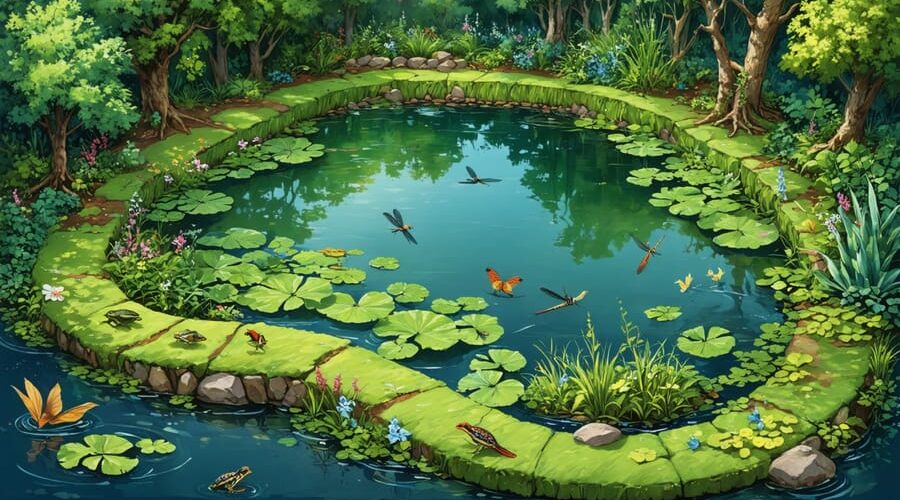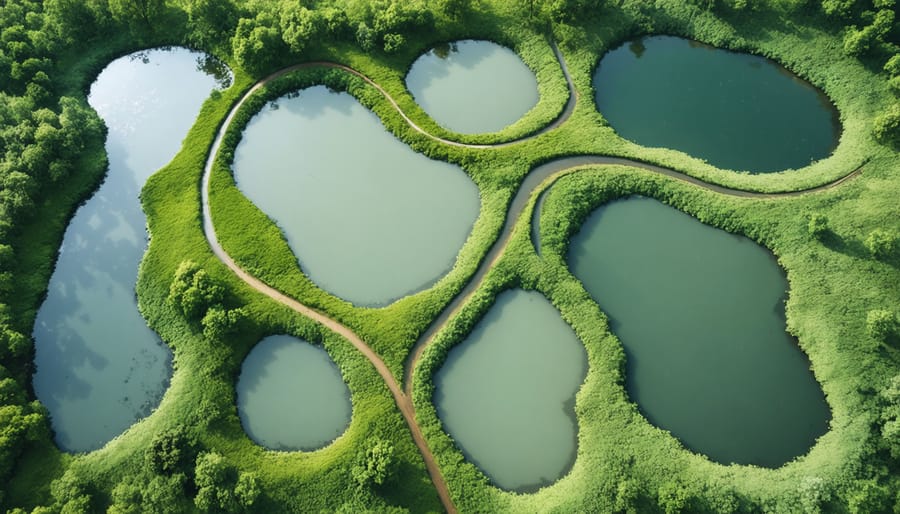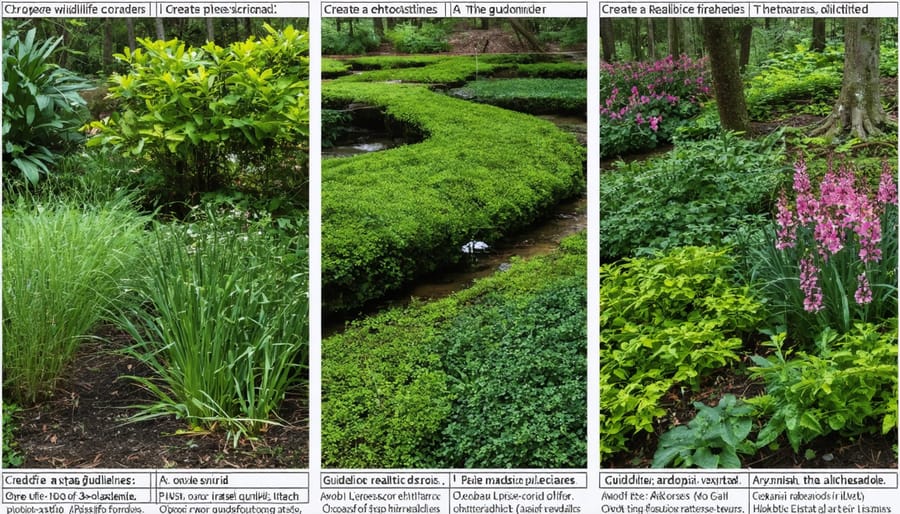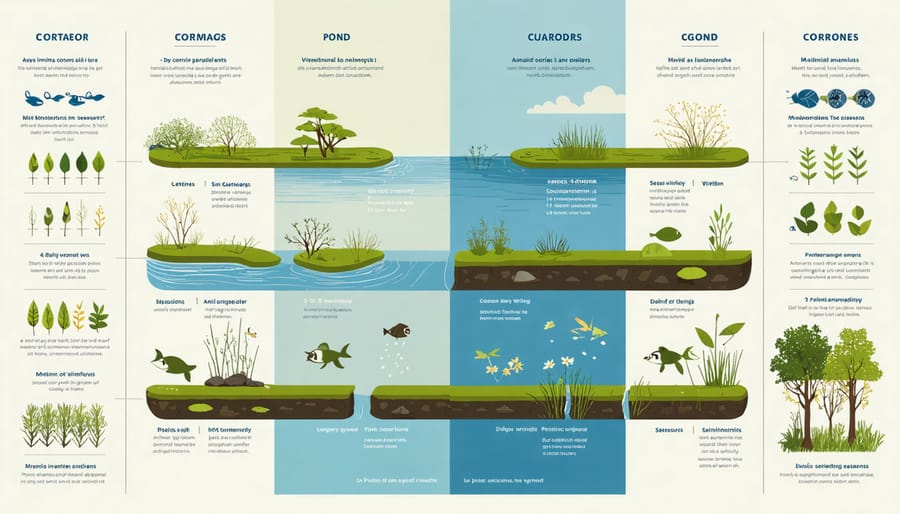
Transform Your Pond into a Thriving Wildlife Highway (Your Complete Habitat Corridor Guide)
Transform your backyard pond into a thriving ecosystem hub by connecting it to the wider environment. Create natural corridors using native plants that extend from your pond’s edges into the surrounding landscape, forming living bridges for wildlife movement. Position logs, rocks, and dense vegetation in strategic paths between your pond and nearby natural areas, establishing safe travel routes for amphibians, insects, and small mammals. Plant diverse, multi-layered vegetation around your pond’s perimeter, incorporating ground covers, mid-height shrubs, and taller trees to support different species’ needs.
These connections aren’t just beautiful – they’re vital lifelines that help local wildlife navigate our increasingly fragmented landscapes. When ponds become isolated, they’re like islands cut off from the mainland. But by linking them to other natural spaces, we create a living network that supports biodiversity, enables species migration, and builds resilience against environmental changes. Every connected pond becomes part of something bigger: a stepping stone in nature’s pathway to survival.
Why Your Pond Needs to Be Part of Nature’s Network

The Hidden Life Between Ponds
Did you know that your garden pond is more than just a standalone water feature? It’s actually part of a much larger living network! Wildlife like frogs, newts, and dragonflies don’t just stay in one place – they need to move between different water sources throughout their lives.
Think of your neighborhood as a giant connect-the-dots puzzle, where each pond, stream, and wetland is a vital point. Animals use these waterways like nature’s highways, traveling to find food, mates, and new homes. Even small creatures like water beetles and damselflies need multiple spots to thrive.
But here’s the challenge: when these natural connections are broken by roads, buildings, or large open spaces, it’s like putting up roadblocks in their path. That’s why creating “stepping stones” between water features is so important. By adding a series of small ponds or bog gardens in your yard, you’re actually building bridges for wildlife.
The most successful pond networks include different types of water features – some deep, some shallow, some with plenty of plants. This variety helps support more species and makes your garden an essential pit stop on nature’s highway system.
Your Pond’s Role in Local Biodiversity
Your backyard pond isn’t just a standalone water feature – it’s a vital link in your local ecosystem’s chain. Think of it as a stepping stone that helps wildlife move between larger natural areas, creating what ecologists call a “wildlife corridor.” When you measure your pond’s biodiversity, you’ll be amazed at the variety of creatures it supports!
From dragonflies using your pond as a breeding ground to birds stopping by for a drink, your water garden creates essential connections for local wildlife. These connections become even more important in urban areas, where natural water sources are scarce. Your pond might be helping frogs move between wetlands, providing a rest stop for migrating birds, or supporting beneficial insects that help pollinate your garden.
The plants around your pond play a crucial role too. Native vegetation creates safe passages for small creatures and attracts local wildlife, turning your yard into a thriving ecosystem hub. By maintaining a healthy pond, you’re not just creating a beautiful garden feature – you’re actively supporting your neighborhood’s natural biodiversity network.
Creating Your Pond Corridor System
Strategic Planting for Wildlife Movement
Creating effective wildlife corridors starts with smart plant selection and placement. The key is to think like the wildlife you want to attract and provide what they need to move safely through your landscape. Start by incorporating wildlife-friendly pond plants around your water feature, then gradually extend plantings outward to connect with nearby natural areas.
Layer your plantings with different heights to create a multi-story habitat. Tall trees provide overhead cover and nesting sites, while shrubs offer mid-level shelter and food sources. Ground covers and low-growing plants create safe passages for smaller creatures like frogs, lizards, and beneficial insects.
Choose native plants whenever possible, as these are already adapted to your local climate and wildlife. Plant in groups rather than single specimens to create denser coverage and more natural-looking corridors. Include flowering plants that bloom at different times throughout the year to ensure continuous food sources for pollinators.
Consider creating “stepping stones” of habitat if you can’t establish continuous corridors. Even small clusters of plants spaced reasonably close together can help wildlife hop from one safe spot to another. Leave some brush piles and fallen logs in place to provide additional shelter and movement pathways.
Remember to avoid using pesticides in these areas, as they can harm the very wildlife you’re trying to attract. Instead, embrace the natural balance that develops when you provide proper habitat connectivity. With time, you’ll notice increased wildlife activity as animals discover and use these green highways through your landscape.

Building Natural Bridges and Passages
Creating natural bridges and passages around your pond isn’t just about aesthetics – it’s about helping wildlife move safely between water areas. Think of these features as wildlife highways that connect different habitats and make your pond a vital part of the local ecosystem.
Start by identifying natural movement patterns in your yard. Look for existing animal trails or areas where you regularly spot wildlife. These are perfect spots to establish your connectivity features. Large, flat stones placed strategically can create stepping stones across shallow sections of your pond, helping smaller animals like frogs and salamanders move safely across the water.
Logs and branches serve as excellent natural bridges. Position them so they extend partially into the water, creating ramps that wildlife can use to enter and exit safely. These features are particularly helpful for turtles, who need easy access points for basking and movement. Make sure these structures are stable and won’t roll when animals climb on them.
Plant corridors are another essential element. Create dense plantings along the edges of your pond that connect to nearby natural areas. Native grasses, shrubs, and ground cover provide cover for small animals moving between water sources. These planted passages also help butterflies, bees, and other pollinators navigate your garden safely.
For smaller ponds, consider building a simple rock wall or pile near the water’s edge. This creates multiple levels and hiding spots that animals can use as they move through your yard. Leave small gaps between rocks to create perfect hideaways for beneficial insects and amphibians.
Remember to maintain these passages throughout the year. Remove any obstacles that might block movement, especially after storms. In winter, try to keep at least one access point clear of snow and ice to help wildlife reach the water. These simple features make a big difference in supporting local wildlife and creating a thriving ecosystem around your pond.
Safe Zones and Shelter Spots
Creating safe zones and shelter spots is like building tiny wildlife sanctuaries in your backyard. Think of these areas as rest stops on a wildlife highway, giving animals safe places to pause during their journeys. Start by designating undisturbed areas around your pond where plants can grow naturally and fallen leaves can accumulate.
Layer your plantings to create multiple hiding spots – tall grasses at the back, medium shrubs in the middle, and ground cover plants in front. Leave some logs and rocks scattered around; these become perfect hideouts for smaller creatures like frogs, newts, and beneficial insects. If you have space, consider creating brush piles using fallen branches and leaves, which provide excellent shelter for birds and small mammals.
Around your pond, maintain some deeper areas with overhanging vegetation where fish can hide from predators. Install floating plants like water lilies that offer shade and protection for aquatic life. Create shallow, gently sloping areas at the pond’s edge – these “beach zones” are perfect for amphibians and insects to safely enter and exit the water.
Remember to leave some wild, unmowed areas in your garden. These natural spaces might look messy to us, but they’re five-star accommodations for wildlife! If you’re worried about appearances, frame these wild areas with neatly trimmed borders to show they’re intentional features of your garden design.
Make sure these safe zones connect to each other and to neighboring natural areas. Even a small strip of native plants can serve as a protective corridor for wildlife moving between sheltered spots.
Maintaining Your Connected Pond Habitat

Seasonal Care for Wildlife Corridors
Maintaining wildlife corridors requires attention throughout the year to ensure they remain effective pathways for local fauna. Understanding seasonal wildlife adaptations helps us provide better care for these vital connections.
In spring, focus on planting native species that provide food and shelter. Remove any winter debris that might block animal movement, but leave some fallen leaves and branches as natural hiding spots. Check for and repair any damage to fencing or markers that guide wildlife through safe passages.
Summer maintenance involves managing vegetation growth to prevent overly dense areas that could impede movement. Keep water features filled and clean, especially during dry spells when animals depend on these resources. Consider creating shaded rest stops using natural materials like log piles or rock formations.
Fall is the time to prepare corridors for winter by ensuring adequate food sources remain accessible. Leave seed heads on plants and maintain berry-producing shrubs. Add extra shelter options like brush piles that small animals can use during harsh weather.
Winter requires minimal intervention, but monitor for fallen trees or branches that might block established paths. Avoid clearing all snow, as many species use snow tunnels for safe travel. If you have water features, maintain ice-free sections to provide drinking access.
Remember to coordinate with neighbors when possible, as wildlife corridors are most effective when maintained consistently across properties. Keep artificial lighting to a minimum and adjust maintenance schedules to avoid peak wildlife activity periods.
Monitoring Wildlife Activity
Monitoring wildlife activity around your ecological corridors is both exciting and essential for understanding how well your connectivity efforts are working. The simplest way to start is by keeping a nature journal, where you can record daily observations of animal visitors and their behaviors.
Trail cameras are fantastic tools for capturing wildlife movement, especially during nighttime hours when many animals are most active. Position these cameras along suspected wildlife paths, near water sources, or where you’ve noticed animal tracks. Remember to check batteries regularly and position cameras at appropriate heights for different species.
Setting up tracking stations using sand or fine soil can help you identify what animals are using your corridors. Spread a thin layer in key areas and check daily for footprints. You can make plaster casts of interesting tracks to start a collection and learn to identify different species.
Look for other signs of wildlife activity too: droppings, fur caught on branches, nibbled plants, or disturbed mulch. These indirect signs can tell you a lot about which animals are using your space and how they’re moving through it.
Encourage more wildlife observations by creating “stopping points” along your corridors. These can include:
– Berry-producing shrubs
– Small brush piles for shelter
– Shallow water sources
– Native flowering plants
– Rock piles for reptiles
Remember to maintain a respectful distance from wildlife and avoid disturbing their natural behaviors. Regular monitoring helps you adjust and improve your connectivity features over time, ensuring they remain effective wildlife passages.
Creating ecological connectivity in your garden isn’t just about building a beautiful water feature – it’s about being part of something bigger. By implementing the strategies we’ve discussed, you’re joining a community of environmentally conscious gardeners who are making a real difference in their local ecosystems.
Remember, every corridor you create, whether it’s a series of small ponds or a carefully planned native plant pathway, helps wildlife move safely through our increasingly fragmented landscapes. Even modest changes, like adding a few native plants or creating small wildlife passages, can have significant impacts on local biodiversity.
Start small if you need to – perhaps with a simple wildlife-friendly pond or a native plant border. As you become more comfortable, you can gradually expand your corridor project. Watch how birds, butterflies, and other wildlife begin to use your space as a stepping stone in their daily journeys.
The most rewarding part is seeing your garden transform into a vibrant ecosystem hub. Keep notes on the new species you observe and share your successes with neighbors – you might inspire them to join in, creating an even larger network of connected habitats.
Don’t be discouraged if things don’t develop overnight. Nature takes time, but with patience and dedication, you’ll create a thriving ecological corridor that benefits both wildlife and your garden’s beauty. Your efforts, combined with those of others, help weave the essential fabric of biodiversity that our natural world desperately needs.
